Changes in PRIMAP-hist v2.6_final compared to v2.5.1_final for Mozambique
2024-09-24
Johannes Gütschow
Change analysis for Mozambique for PRIMAP-hist v2.6_final compared to v2.5.1_final
Overview over emissions by sector and gas
The following figures show the aggregate national total emissions excluding LULUCF AR6GWP100 for the country reported priority scenario. The dotted linesshow the v2.5.1_final data.

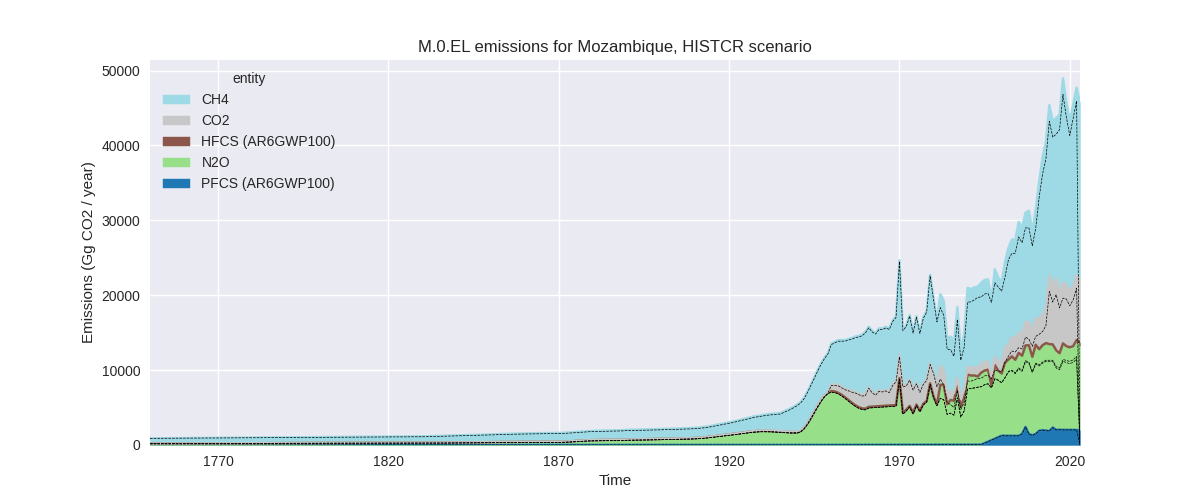
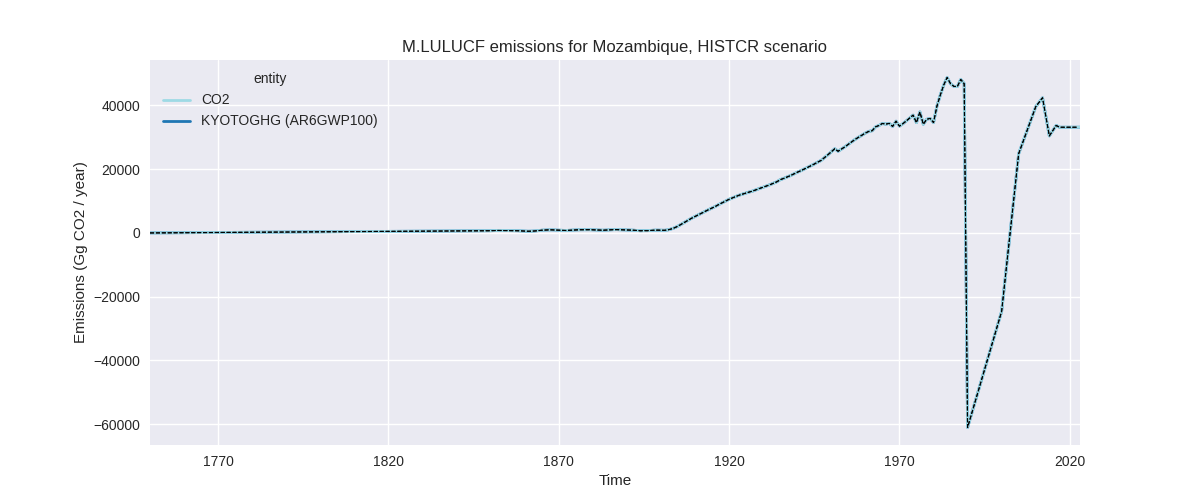
The following figures show the aggregate national total emissions excluding LULUCF AR6GWP100 for the third party priority scenario. The dotted linesshow the v2.5.1_final data.
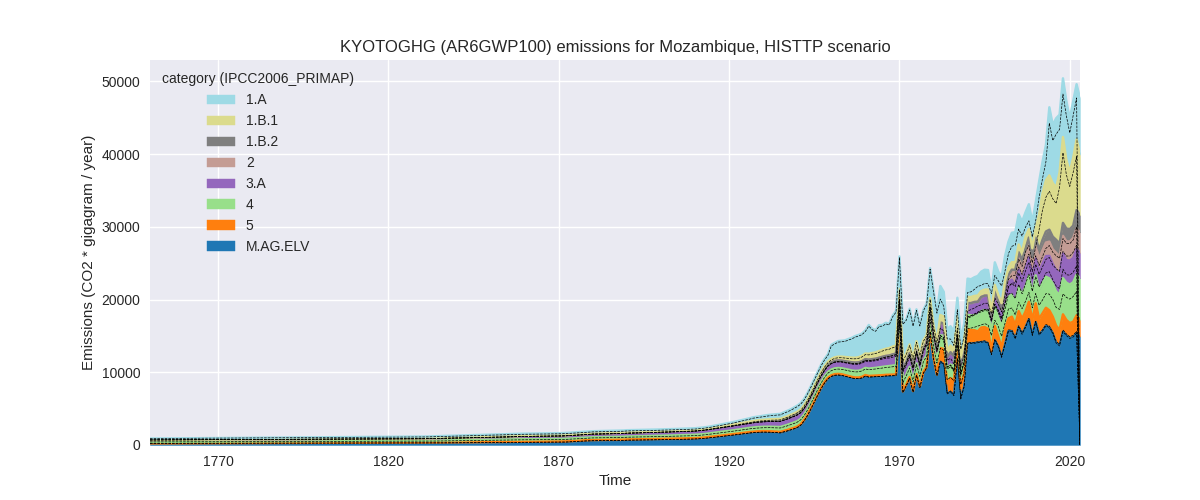


Overview over changes
In the country reported priority scenario we have the following changes for aggregate Kyoto GHG and national total emissions excluding LULUCF (M.0.EL):
- Emissions in 2022 have changed by 3.9%% (1782.74 Gg CO2 / year)
- Emissions in 1990-2022 have changed by 6.3%% (1868.86 Gg CO2 / year)
In the third party priority scenario we have the following changes for aggregate Kyoto GHG and national total emissions excluding LULUCF (M.0.EL):
- Emissions in 2022 have changed by 4.0%% (1885.04 Gg CO2 / year)
- Emissions in 1990-2022 have changed by 6.0%% (1890.50 Gg CO2 / year)
Most important changes per scenario and time frame
In the country reported priority scenario the following sector-gas combinations have the highest absolute impact on national total KyotoGHG (AR6GWP100) emissions in 2022 (top 5):
- 1: 5, N2O with 2195.19 Gg CO2 / year (789.1%)
- 2: 1.A, CO2 with -430.01 Gg CO2 / year (-7.2%)
- 3: 4, CH4 with 35.37 Gg CO2 / year (2.2%)
- 4: 4, CO2 with -11.17 Gg CO2 / year (-55.6%)
- 5: 2, PFCS (AR6GWP100) with -7.37 Gg CO2 / year (-0.4%)
In the country reported priority scenario the following sector-gas combinations have the highest absolute impact on national total KyotoGHG (AR6GWP100) emissions in 1990-2022 (top 5):
- 1: 5, N2O with 1879.33 Gg CO2 / year (1073.0%)
- 2: 1.A, CO2 with -13.32 Gg CO2 / year (-0.5%)
- 3: 4, CH4 with 4.51 Gg CO2 / year (0.7%)
- 4: 4, CO2 with -1.22 Gg CO2 / year (-19.4%)
- 5: 4, N2O with -0.37 Gg CO2 / year (-0.6%)
In the third party priority scenario the following sector-gas combinations have the highest absolute impact on national total KyotoGHG (AR6GWP100) emissions in 2022 (top 5):
- 1: 5, N2O with 2195.19 Gg CO2 / year (789.1%)
- 2: 1.A, CO2 with -430.01 Gg CO2 / year (-7.2%)
- 3: 4, CH4 with 99.65 Gg CO2 / year (1.9%)
- 4: 4, N2O with 23.92 Gg CO2 / year (8.2%)
- 5: 4, CO2 with -11.17 Gg CO2 / year (-55.6%)
In the third party priority scenario the following sector-gas combinations have the highest absolute impact on national total KyotoGHG (AR6GWP100) emissions in 1990-2022 (top 5):
- 1: 5, N2O with 1879.33 Gg CO2 / year (1073.0%)
- 2: 4, N2O with 19.18 Gg CO2 / year (11.6%)
- 3: 1.A, CO2 with -13.32 Gg CO2 / year (-0.5%)
- 4: 4, CH4 with 6.30 Gg CO2 / year (0.2%)
- 5: 4, CO2 with -1.22 Gg CO2 / year (-19.4%)
Notes on data changes
Here we list notes explaining important emissions changes for the country. ’' means that the following text only applies to the TP time series, while means that it only applies to the CR scenario. Otherwise the note applies to both scenarios.
- “other” N2O is much higher because we have removed the FAOSTAT data
- Energy CO2 data for 2022 has changed because of changes in EI data.
- CR and TP time-series are identical
Changes by sector and gas
For each scenario and time frame the changes are displayed for all individual sectors and all individual gases. In the sector plot we use aggregate Kyoto GHGs in AR6GWP100. In the gas plot we usenational total emissions without LULUCF. ## country reported scenario
2022
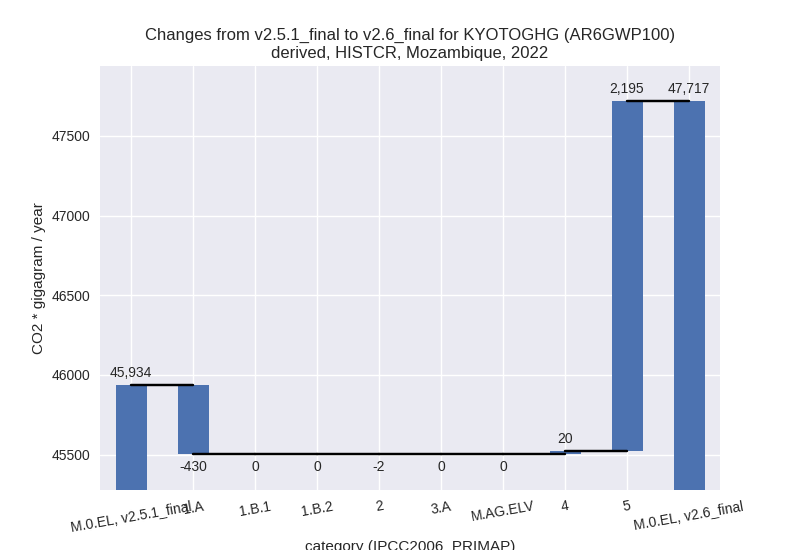

1990-2022
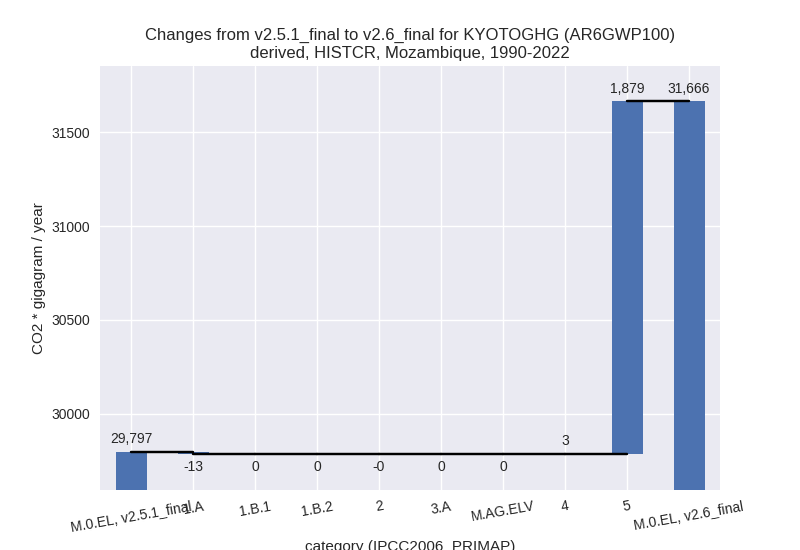
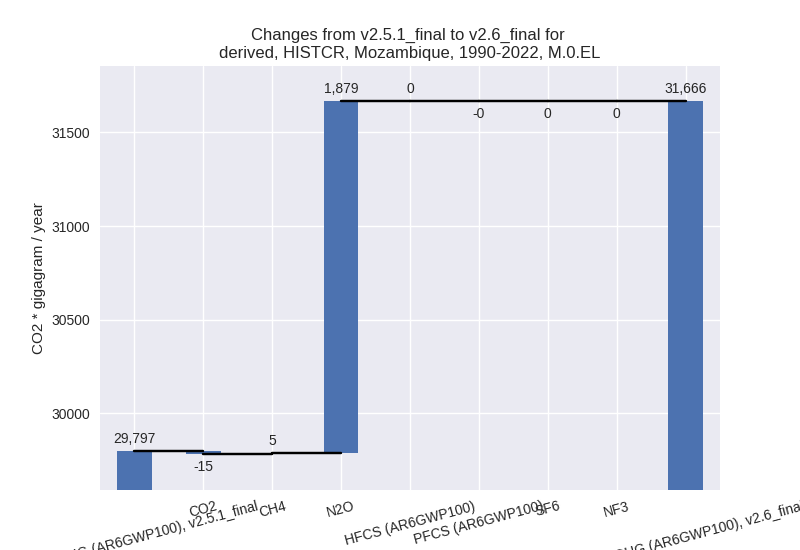
third party scenario
2022

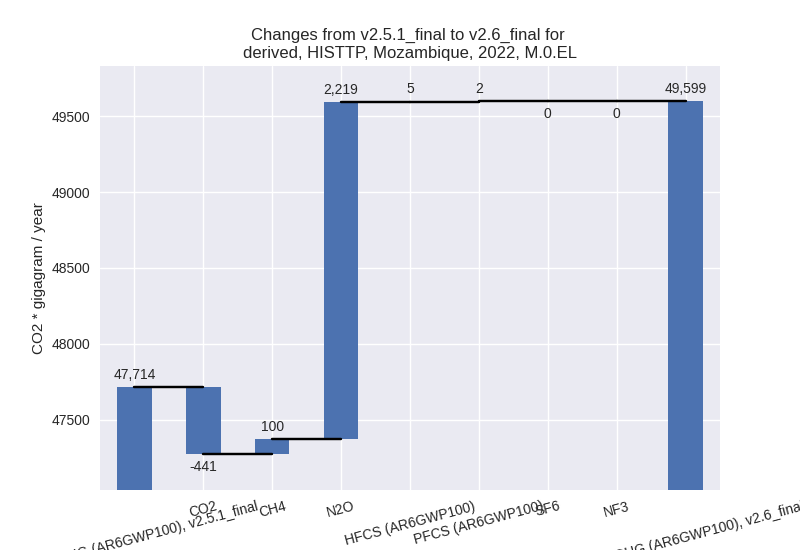
1990-2022

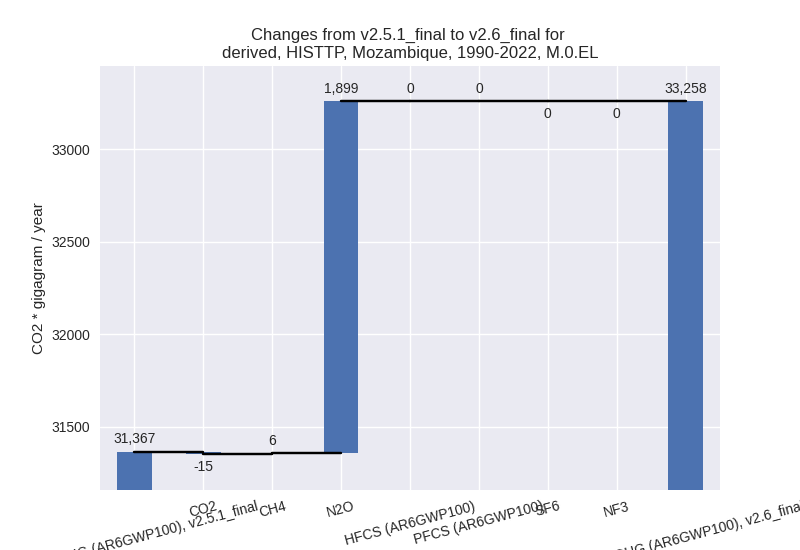
Detailed changes for the scenarios:
country reported scenario (HISTCR):
Most important changes per time frame
For 2022 the following sector-gas combinations have the highest absolute impact on national total KyotoGHG (AR6GWP100) emissions in 2022 (top 5):
- 1: 5, N2O with 2195.19 Gg CO2 / year (789.1%)
- 2: 1.A, CO2 with -430.01 Gg CO2 / year (-7.2%)
- 3: 4, CH4 with 35.37 Gg CO2 / year (2.2%)
- 4: 4, CO2 with -11.17 Gg CO2 / year (-55.6%)
- 5: 2, PFCS (AR6GWP100) with -7.37 Gg CO2 / year (-0.4%)
For 1990-2022 the following sector-gas combinations have the highest absolute impact on national total KyotoGHG (AR6GWP100) emissions in 1990-2022 (top 5):
- 1: 5, N2O with 1879.33 Gg CO2 / year (1073.0%)
- 2: 1.A, CO2 with -13.32 Gg CO2 / year (-0.5%)
- 3: 4, CH4 with 4.51 Gg CO2 / year (0.7%)
- 4: 4, CO2 with -1.22 Gg CO2 / year (-19.4%)
- 5: 4, N2O with -0.37 Gg CO2 / year (-0.6%)
Changes in the main sectors for aggregate KyotoGHG (AR6GWP100) are
- 1: Total sectoral emissions in 2022 are 19842.43 Gg
CO2 / year which is 41.6% of M.0.EL emissions. 2022 Emissions have
changed by -2.1% (-430.01 Gg CO2 /
year). 1990-2022 Emissions have changed by -0.1% (-13.32 Gg CO2 / year). For 2022 the
changes per gas
are:
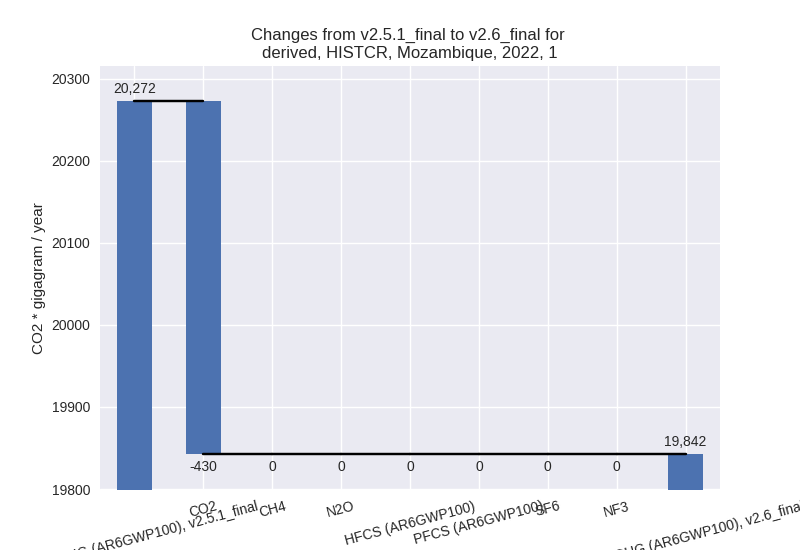
The changes come from the following subsectors:- 1.A: Total sectoral emissions in 2022 are 7591.84
Gg CO2 / year which is 38.3% of category 1 emissions. 2022 Emissions
have changed by -5.4% (-430.01 Gg
CO2 / year). 1990-2022 Emissions have changed by -0.3% (-13.32 Gg CO2 / year). For 2022 the
changes per gas
are:
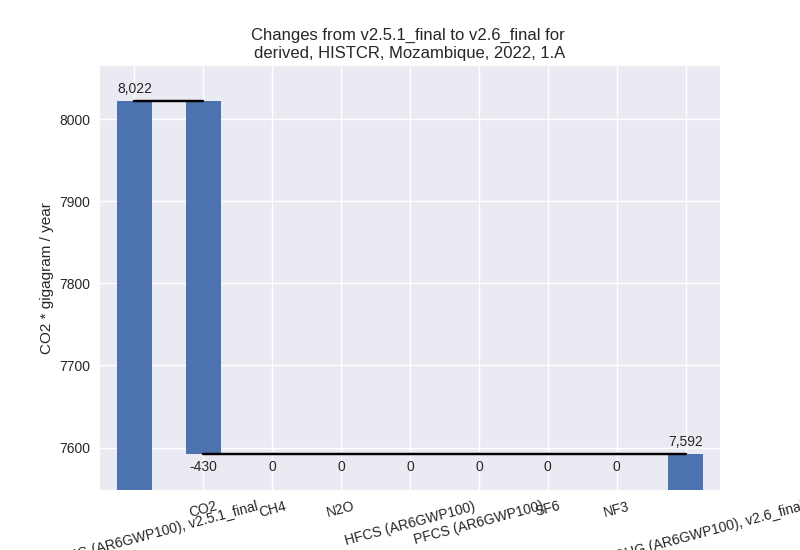
There is no subsector information available in PRIMAP-hist. - 1.B.1: Total sectoral emissions in 2022 are 9697.85 Gg CO2 / year which is 48.9% of category 1 emissions. 2022 Emissions have changed by 0.0% (0.00 Gg CO2 / year). 1990-2022 Emissions have changed by 0.0% (0.00 Gg CO2 / year).
- 1.B.2: Total sectoral emissions in 2022 are 2552.75 Gg CO2 / year which is 12.9% of category 1 emissions. 2022 Emissions have changed by 0.0% (0.00 Gg CO2 / year). 1990-2022 Emissions have changed by 0.0% (0.00 Gg CO2 / year).
- 1.A: Total sectoral emissions in 2022 are 7591.84
Gg CO2 / year which is 38.3% of category 1 emissions. 2022 Emissions
have changed by -5.4% (-430.01 Gg
CO2 / year). 1990-2022 Emissions have changed by -0.3% (-13.32 Gg CO2 / year). For 2022 the
changes per gas
are:
- 2: Total sectoral emissions in 2022 are 4720.29 Gg CO2 / year which is 9.9% of M.0.EL emissions. 2022 Emissions have changed by -0.0% (-2.18 Gg CO2 / year). 1990-2022 Emissions have changed by -0.0% (-0.07 Gg CO2 / year).
- M.AG: Total sectoral emissions in 2022 are 18872.79 Gg CO2 / year which is 39.6% of M.0.EL emissions. 2022 Emissions have changed by 0.0% (0.00 Gg CO2 / year). 1990-2022 Emissions have changed by 0.0% (0.00 Gg CO2 / year).
- 4: Total sectoral emissions in 2022 are 1808.03 Gg CO2 / year which is 3.8% of M.0.EL emissions. 2022 Emissions have changed by 1.1% (19.75 Gg CO2 / year). 1990-2022 Emissions have changed by 0.4% (2.92 Gg CO2 / year).
- 5: Total sectoral emissions in 2022 are 2473.39 Gg
CO2 / year which is 5.2% of M.0.EL emissions. 2022 Emissions have
changed by 789.1% (2195.19 Gg CO2 /
year). 1990-2022 Emissions have changed by 1073.0% (1879.33 Gg CO2 / year). For 2022
the changes per gas
are:

For 1990-2022 the changes per gas are: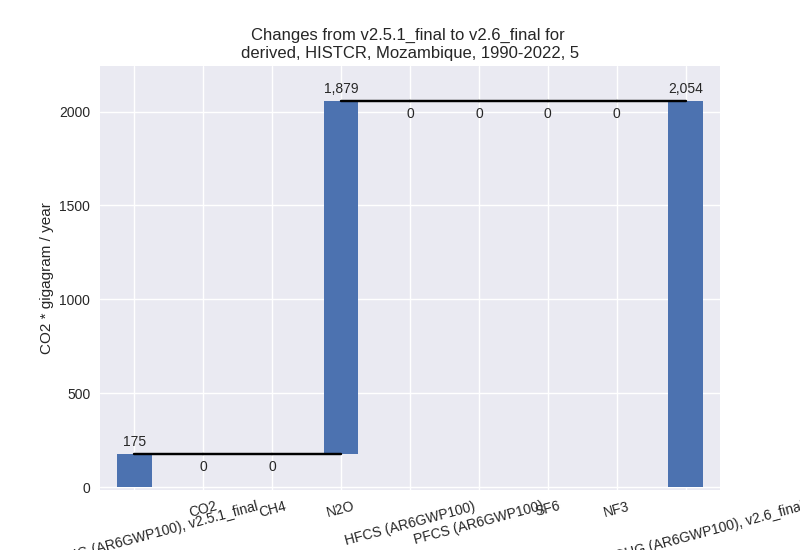
third party scenario (HISTTP):
Most important changes per time frame
For 2022 the following sector-gas combinations have the highest absolute impact on national total KyotoGHG (AR6GWP100) emissions in 2022 (top 5):
- 1: 5, N2O with 2195.19 Gg CO2 / year (789.1%)
- 2: 1.A, CO2 with -430.01 Gg CO2 / year (-7.2%)
- 3: 4, CH4 with 99.65 Gg CO2 / year (1.9%)
- 4: 4, N2O with 23.92 Gg CO2 / year (8.2%)
- 5: 4, CO2 with -11.17 Gg CO2 / year (-55.6%)
For 1990-2022 the following sector-gas combinations have the highest absolute impact on national total KyotoGHG (AR6GWP100) emissions in 1990-2022 (top 5):
- 1: 5, N2O with 1879.33 Gg CO2 / year (1073.0%)
- 2: 4, N2O with 19.18 Gg CO2 / year (11.6%)
- 3: 1.A, CO2 with -13.32 Gg CO2 / year (-0.5%)
- 4: 4, CH4 with 6.30 Gg CO2 / year (0.2%)
- 5: 4, CO2 with -1.22 Gg CO2 / year (-19.4%)
Changes in the main sectors for aggregate KyotoGHG (AR6GWP100) are
- 1: Total sectoral emissions in 2022 are 19842.43 Gg
CO2 / year which is 40.0% of M.0.EL emissions. 2022 Emissions have
changed by -2.1% (-430.01 Gg CO2 /
year). 1990-2022 Emissions have changed by -0.1% (-13.32 Gg CO2 / year). For 2022 the
changes per gas
are:
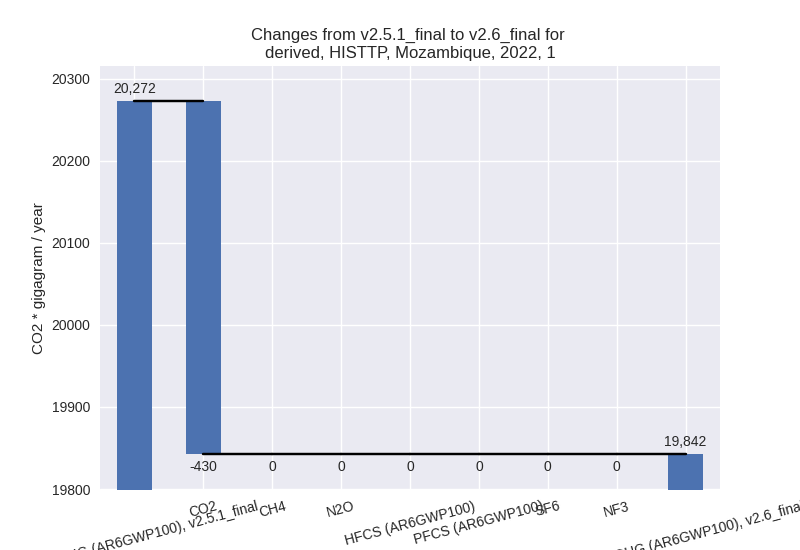
The changes come from the following subsectors:- 1.A: Total sectoral emissions in 2022 are 7591.84
Gg CO2 / year which is 38.3% of category 1 emissions. 2022 Emissions
have changed by -5.4% (-430.01 Gg
CO2 / year). 1990-2022 Emissions have changed by -0.3% (-13.32 Gg CO2 / year). For 2022 the
changes per gas
are:

There is no subsector information available in PRIMAP-hist. - 1.B.1: Total sectoral emissions in 2022 are 9697.85 Gg CO2 / year which is 48.9% of category 1 emissions. 2022 Emissions have changed by 0.0% (0.00 Gg CO2 / year). 1990-2022 Emissions have changed by 0.0% (0.00 Gg CO2 / year).
- 1.B.2: Total sectoral emissions in 2022 are 2552.75 Gg CO2 / year which is 12.9% of category 1 emissions. 2022 Emissions have changed by 0.0% (0.00 Gg CO2 / year). 1990-2022 Emissions have changed by 0.0% (0.00 Gg CO2 / year).
- 1.A: Total sectoral emissions in 2022 are 7591.84
Gg CO2 / year which is 38.3% of category 1 emissions. 2022 Emissions
have changed by -5.4% (-430.01 Gg
CO2 / year). 1990-2022 Emissions have changed by -0.3% (-13.32 Gg CO2 / year). For 2022 the
changes per gas
are:
- 2: Total sectoral emissions in 2022 are 2812.62 Gg CO2 / year which is 5.7% of M.0.EL emissions. 2022 Emissions have changed by 0.3% (7.47 Gg CO2 / year). 1990-2022 Emissions have changed by 0.0% (0.23 Gg CO2 / year).
- M.AG: Total sectoral emissions in 2022 are 18872.79 Gg CO2 / year which is 38.1% of M.0.EL emissions. 2022 Emissions have changed by 0.0% (0.00 Gg CO2 / year). 1990-2022 Emissions have changed by 0.0% (0.00 Gg CO2 / year).
- 4: Total sectoral emissions in 2022 are 5597.48 Gg
CO2 / year which is 11.3% of M.0.EL emissions. 2022 Emissions have
changed by 2.0% (112.39 Gg CO2 /
year). 1990-2022 Emissions have changed by 0.7% (24.26 Gg CO2 / year). For 2022 the
changes per gas
are:
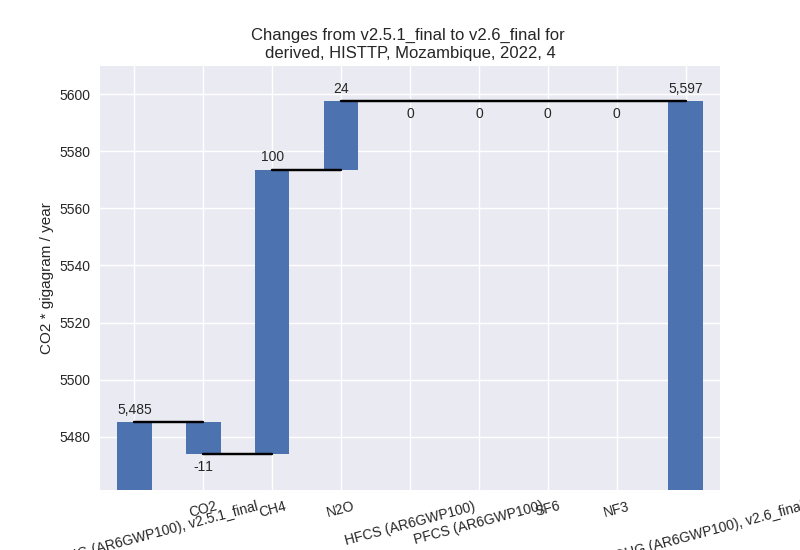
- 5: Total sectoral emissions in 2022 are 2473.39 Gg
CO2 / year which is 5.0% of M.0.EL emissions. 2022 Emissions have
changed by 789.1% (2195.19 Gg CO2 /
year). 1990-2022 Emissions have changed by 1073.0% (1879.33 Gg CO2 / year). For 2022
the changes per gas
are:
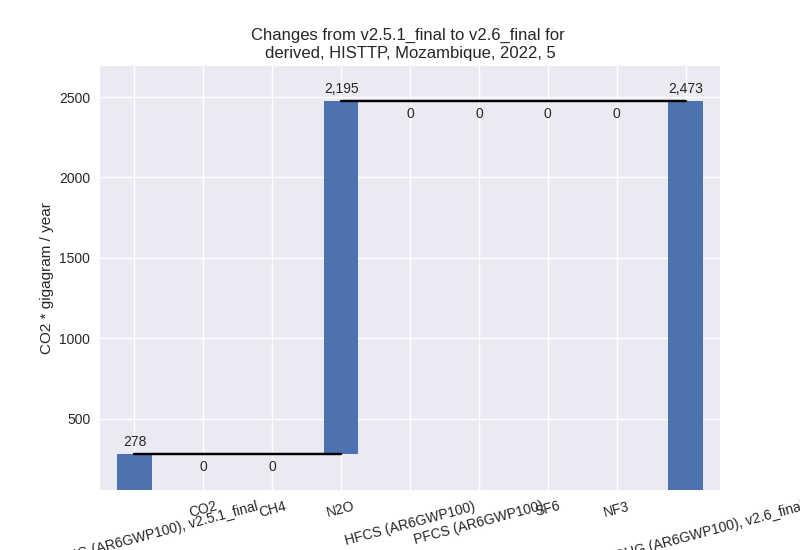
For 1990-2022 the changes per gas are: